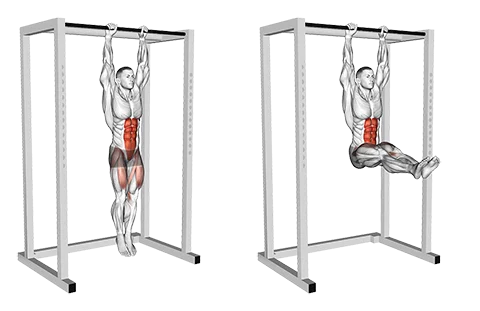Introduction
The Hanging Leg Raise is a core exercise where you lift your legs while hanging from a pull-up bar or other sturdy overhead support. It primarily strengthens the abdominal muscles, hip flexors, and lower back. This exercise is particularly effective for building functional core strength, improving posture, and enhancing athletic performance by engaging multiple muscle groups in a dynamic motion.
Muscles Worked
- Primary: Abdominal muscles (Rectus abdominis, obliques)
- Secondary: Hip flexors (Iliopsoas, rectus femoris), lower back muscles (Erector spinae)
How to Do It (Step-by-Step)
- Lie on your back with your legs extended and crossed at the ankles over a pull-up bar or parallel bars. Your arms should be straight with palms facing down.
- Raise your legs slowly towards your chest while keeping them crossed and maintaining a stable lower back.
- Pause briefly at the top, then lower your legs back to the starting position slowly. Keep your core engaged throughout the movement.
Tip: To prevent lower back strain, ensure your hips don't swing or rock during the exercise. Keep your abs tight and control the movement with your core muscles.
Rep & Rest Guidelines
- Strength: 4–6 reps, 2–3 min rest
- Hypertrophy: 8–12 reps, 60–90 sec rest
- Endurance: 12–20 reps, 30–60 sec rest
Boost your workouts with Auto Progression and stay on track with Rest Timer.
Form Tips
- Maintain a straight body posture throughout the exercise, ensuring that the lower back remains in contact with the ground.
- Keep your legs together and pointed towards the ceiling during the lift. Avoid swinging or using momentum to raise your legs.
- Breathe naturally, inhaling as you lower your legs and exhaling as you lift them. Engage your core muscles to control the movement throughout the exercise.
When to Use It
- Improving Core Strength and Defining Abs: Hanging leg raises are effective for building a strong, defined core by targeting the lower abs and obliques.
- Enhancing Lower Back Health and Strength: This exercise helps to strengthen the lower back muscles, improving posture and reducing lower back pain over time.
- Boosting Gymnastics Skills: Hanging leg raises are beneficial for gymnasts and other athletes looking to improve their hip flexor strength and control in advanced skills like the muscle-up and straddle planche.
Discover your workout history with ease
A hanging leg raise primarily targets the rectus abdominis, obliques, and hip flexors.
Perform 2-4 sets with 8-15 repetitions, depending on your fitness level and goals.
Maintain a straight body position with your legs extended at the top, then bend your knees to bring them towards your chest.
Consult a professional trainer or physical therapist before attempting hanging leg raises if you have back problems.
Hanging leg raises require a pull-up bar or similar equipment where you can hang with your legs extended below you.

